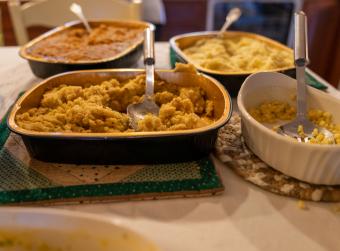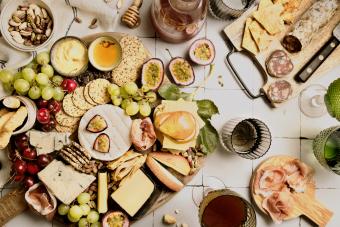
Cooking up recipes to enjoy dishes that have been passed down for generations in your family is a timeless tradition that many people utilize to honor their culture and roots. Take your love of family, heritage, and food to the next level by compiling your favorite recipes into a family cookbook. Making a family cookbook is a fantastic way to preserve kitchen traditions so future generations can serve up classic family dishes to their kin someday.
Cookbook Design and Theme
When designing a cookbook for your family to enjoy for years to come, the possibilities are endless. You can choose any design pleasing to your eye and include whatever recipes you think will best benefit your brood. You can ask family members contributing to the cookbook to handwrite the recipe and instructions, as that captures the authenticity of the people crafting the recipes. You can also opt to type the recipes, print them, and laminate the pages, or you can utilize the internet, submitting your recipes and images to any number of sites that will transform your vision into a tangible book to cherish for years to come.
Curating the Recipes
You may want to curate the recipes into the categories of dinners or desserts exclusively, or you can include recipe ideas for all aspects of cooking, baking and creating food in the kitchen. You may choose to use the recipes you have on hand, or you can reach out to extended family for their favorite culinary masterpieces. You can also organize your cookbook by holidays. If you know that the favorite family recipes are ones that make an appearance over Christmas, Easter or Thanksgiving, choose to get inspired by seasons and make a family cookbook to guide future kin in holiday hosting.
Rounding Up Recipes
Surely you have a handful of recipes at your disposal that you will want to include in your cookbook. Maybe you bake Thanksgiving pies from your grandma's recipe or make sweet potatoes the way your mom taught you. What do you find yourself making time after time? These can be added to traditional family recipes, and in the decades to come, they might end up being the dishes your children make for your grandchildren!
If you want to ask grandparents, aunts, and uncles for their favorite recipes, consider creating a general email that will outline the project and what you need from willing participants. In your email, be sure to mention:
- The purpose of the cookbook
- Your request for one family recipe (either their own family favorite or a recipe they received from a family member).
- If the recipe has a backstory, ask for that to be included.
- The ingredient list and all measurements (this is important because people who make the same dish repeatedly find they no longer need to measure every item out. Since you are not the original chef behind these recipe contributions, you will need measurements).
- The steps to creating the recipe and the baking instructions.
- Any additional pairing or serving suggestions (What does the contributor typically serve with this dish)?
- A timeframe: ask for a deadline for all recipes to be submitted.
- Any photographs of their family making or eating the recipe. These visuals can often be scanned and emailed to you.

Assembling the Cookbook
Once you have every recipe and correlating instructions on hand, determine a layout for your recipes. If you are using a company that takes your ideas and puts them in book form, you will need to upload what you have to the site.
If you are forgoing that option and compiling the book by hand, you will need to organize recipes in the order you want them to appear. If the recipes are all handwritten and have images to go with them, arrange these on an 8 x 11 sheet of paper and laminate them, or slip them into a protective slip.
If you choose to type every recipe, type what you have and print the recipes to be added to the book. You may want to keep your recipes in a 3-ringed binder so you can add more recipes as you go. Regardless of which assembly model you choose to follow, make sure to add in as many personal touches and artifacts as possible. Family cookbooks are all about memories, traditions, and the people you love. Images, stories, or even scraps of aprons can give your cookbook unique and creative flair.
Selecting a Digital Service
While you might choose to type out your book or request handwritten recipes, you can also look into putting a professional spin on your creation. Digital companies take your ideas and compile them into a book that looks like it should be sitting on the shelves of Barnes & Noble. Some popular companies that may help you bring your cookbook vision to life are:
- Snapfish - An 8 x 11 recipe book made using Snapfish starts at 39.99 for 20 pages.
- Shutterfly - Shutterfly's cookbook option makes your recipes look as professional and aesthetically pleasing as possible, but it won't come cheap. Their cookbook option costs about $230.
- MyCanvas - MyCanvas has a softcover and hardcover photo book option that you could use to create a cookbook. Options might be more limited with this digital company, but if you snapped an image of the recipe and uploaded that to the photo book, it would be done for relatively cheap. Softcover photo books start at $12.
- HeritageCookbook.com - If you plan to make several copies of your cookbook for family members, HeritageCookbook is an excellent resource to try.
- CreateMyCookbook - This site is devoted to helping people make a beautiful and customized cookbook reflecting their family's culinary prowess and heritage. Prices range from $9.94 for an eCookbook to $42.95 for a ringed binder.
- Bookbaby.com - Bookbaby.com helps you create a cookbook and even sell it if you choose to turn family recipes into a family business.
Cookbook Considerations
While the design and layout of your cookbook are entirely up to you, you may want to consider adding the following elements into your book so that it isn't simply recipes and a smattering of images.
- A table of contents
- Small sections under each recipe for substitutions if the recipe includes common allergens
- A biography about yourself and a summary as to why you decided to put the book together
- A family tree
- A large image of your family
Family Cookbooks House History
Family recipe books house so much more than the potential for great meals. They tell the story of your family culture. Each recipe has a person or a lineage of people and stories that go with it. Use a family recipe book as a one-stop shop for great food ideas and a space to reflect and connect with your roots.







